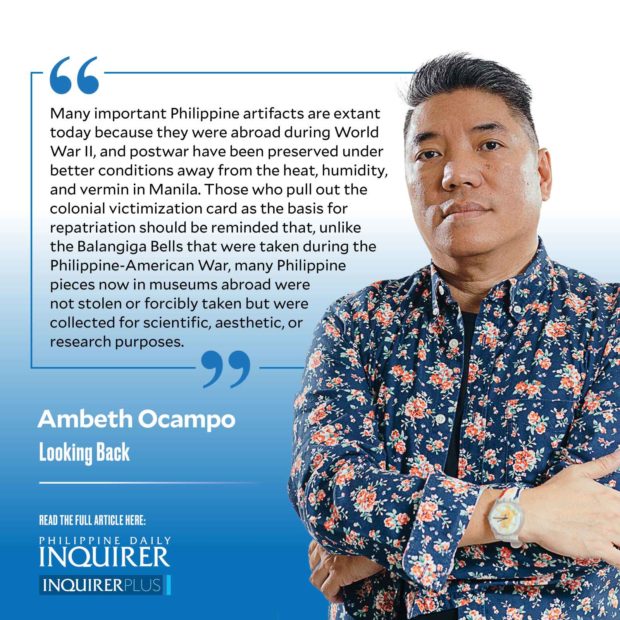
Many important Philippine artifacts are extant today because they were abroad during World War II, and postwar have been preserved under better conditions away from the heat, humidity, and vermin in Manila. Those who pull out the colonial victimization card as the basis for repatriation should be reminded that, unlike the Balangiga Bells that were taken during the Philippine-American War, many Philippine pieces now in museums abroad were not stolen or forcibly taken but were collected for scientific, aesthetic, or research purposes.
Following the trail of Jose Rizal abroad has led me not just to the sites where he lived or walked in Berlin, Hong Kong, London, Madrid, New York, Paris, Tokyo, San Francisco, Singapore, Yokohama, etc. but to institutions that have “Rizaliana.” The Newberry Library in Chicago has the collection of Edward E. Ayer who started buying Filipiniana when the Philippines changed hands from Spain to the US at the end of the Spanish-American War in 1898. Ayer’s collection of rare Philippine books and manuscripts includes handwritten diaries and letters of Rizal. A diary from 1884, for example, was acquired from Rizal’s “frenemy” Wenceslao E. Retana.
An enemy in Rizal’s lifetime, Retana changed spots after Rizal’s death and published “Vida y escritos del Dr. Jose Rizal (1907),” the first full-length and adoring biography of our national hero. Retana acquired the 1884 Rizal diary from Clemente J. Zulueta. I cannot ascertain whether the sale was done before or after Zulueta was commissioned to acquire all extant Rizaliana abroad and repatriate these to the Philippines. We do not need to have the originals back because photostatic copies were donated to the National Library by the Newberry in 1961, and it is accessible to anyone who visits the library for research.
It is not well-known that Rizal was a collector who donated to ethnological museums in Dresden and Berlin. I have visited Dresden twice and have seen the objects: four wooden spoons from the Cordilleras, a brass betel nut presentation tray, a barong or cutlass with a wooden sheath, etc. that Rizal sent to the ethnologist Adolf Bernhard Meyer from Dapitan in exchange for books to while away the hours of exile from 1892 to 1896.
Part of Rizal’s correspondence with Meyer is preserved in the Newberry Library. Most of the Rizal collection in Dresden awaits further research because aside from a monograph on the shells he collected in Dapitan, we only know about a winged lizard (Draco rizali), a frog (Rhacophorus rizali), and a beetle (Apogonia rizali) as listed by the naturalist Benno Wandolleck in 1900. Since I barely passed natural science in high school and college, I leave those for more competent researchers.
Then there is the Berlin Rizal collection. In 1998, after a special screening of Marilou Diaz Abaya’s film “Jose Rizal,” the director pulled me aside and advised me to look up the Rizal collection in Berlin. She described the woman’s ensemble in great detail: a jusi blouse with silk stripes, a pañuelo or large scarf of nipis, a veil, a dark silk tapis, and a pink skirt with brown sinamay or abaca lining. Abaya was so impressed by the high quality of the clothes she concluded, with a knowing smile, that these could not have been collected by a straight man. The suggestion that Rizal was gay or one of the earliest Filipino metrosexuals is left to your imagination. I presume these clothes were sourced and chosen by Rizal’s mother or any of his seven sisters. Saturnina, the eldest, and the younger spinster sisters, Trinidad and Josefa, operated a textile store in prewar Manila.
The real treasure in Berlin is an exquisite salakot made from carabao horn and ornamented with silver that was Rizal’s own, his personal salakot. Those who might call for repatriation should be reminded that Rizal himself donated these objects to the museum and that we should be happy with digital repatriation through high-resolution images available online for research and enjoyment.
Comments are welcome at aocampo@ateneo.edu

